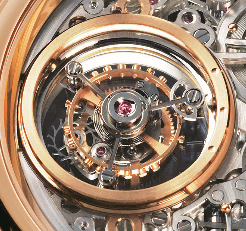A device designed to compensate for timing errors in mechanical watches caused by the effects of gravity. A tourbillon (French for “whirlwind”) consists of a cage that encloses the balance and escapement. The cage rotates around its own axis, usually at the rate of once per minute. This constant rotation compensates for the effects of gravity when the watch is in a vertical position and thus supposedly improves the accuracy of the timepiece. The tourbillon has no effect on the accuracy when the watch is in a horizontal position. The tourbillon was invented by Abraham-Louis Breguet and patented by him in 1801, during the age of pocketwatches. It is generally believed that, because pocketwatches are usually carried in a vertical position, they are far more likely to benefit from tourbillons than are wristwatches.

Click here to go to the Watchmaking Glossary main page
All items in T:
